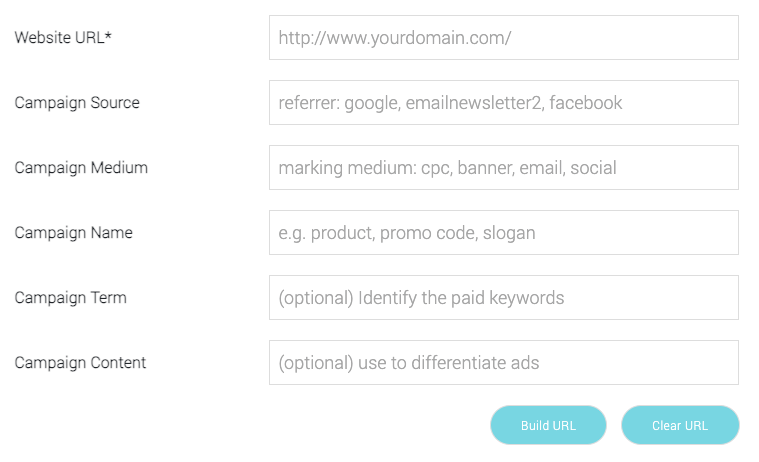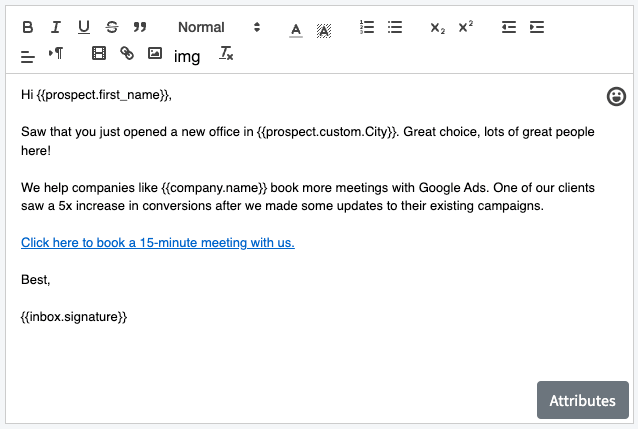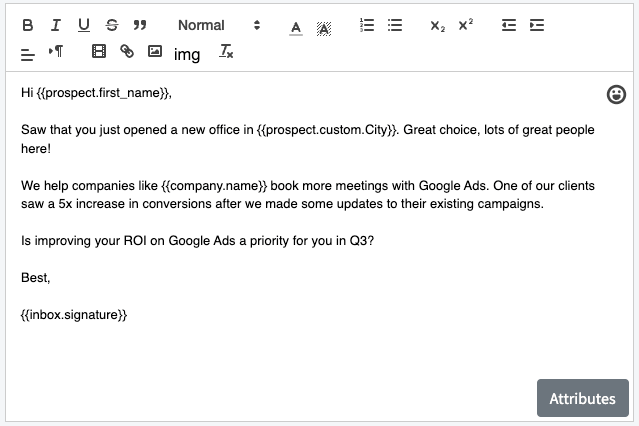Key Takeaways
- Link tracking allows you to see how many people interact with links in your cold email campaigns and identify which campaign and email they came from. These details can help you understand if your recipients are interested in your offer and help you compare emails in your campaign against each other.
- You can track links in your cold email outreach in two ways:
- Using the custom domain tracking that’s integrated into most cold email platforms.
- Using custom UTM tracking, which gives you control over how the visitors who click your links are tracked in your website analytics tool and lets you segment visitors by click source.
- However, tracking links has its downsides. The first major downside is that including links in emails can negatively impact your email deliverability. Link tracking can also lead to missed opportunities if your recipient doesn’t want to click a link and would prefer to have a conversation instead.
- We recommend only tracking links in your cold outreach if there’s a specific and necessary reason. In most cases, you’ll be better off leaving your links out and using a call-to-action that’s designed to generate a reply.
Link tracking can help you gather important data on your cold email campaign performance. However, link tracking doesn’t come without risks — it can hurt your email deliverability and lead to you getting fewer replies from your recipients.
In this guide, we’ll walk you through everything you need to know about cold email link tracking. You’ll learn what it is, why it is essential, the pros and cons of link tracking, and more.
What Is Link Tracking and How Does It Work in Cold Emails?
Link tracking is the process of tracking how many people click on links you include in your cold outreach campaigns. It can give you an indication of how engaging your call-to-action is, and whether your recipients trust you enough to click the link.
Link tracking can be done in two ways.
The first is using cold email software’s built-in custom domain tracking features. These work by adding a custom tracking link to any link you add to your cold email template, which is then tracked. You’ll primarily see these reported in your cold email software.
The second common way to track link clicks is with UTM parameters. UTMs are standardized extensions added to your URL, and they let you track the source of the click and any custom campaign parameters you need to know in your reporting. These URLs usually won’t be tracked by your cold email tool, but the link clicks will show up in your Google Analytics or similar analytics platform.
You can quickly build a UTM using a UTM builder. Add your campaign source, medium, and name, and it’ll automatically build the URL for you.
Pros and Cons of Link Tracking in Cold Email
Tracking links can give you critical insights into your email performance and help you understand how your recipients engage with your email content. But, there are some downsides, such as how links can hurt email deliverability.
You need to weigh the pros and cons of link tracking and decide if you will include them in your next campaign.
Pro: It Doesn’t Require a Reply to Generate Interest
If someone clicks on a link, you can see that there’s some interest even if they don’t reply immediately.
If they don’t get back to you, you can use the info that they’ve actively clicked a link in your email to personalize your follow-up email and boost your chances of getting a reply.
Pro: You Can See Which Prospects are Engaging With Your Content
Cold email link tracking lets you track how effective your call-to-actions are.
If the link you included goes to your demo booking page, you can track how many people are clicking it and showing interest. You could even A/B test two links against each other to see which one gets the most clicks. Because you have accurate data, you’ll instantly know which one is more effective.
Pro: You Can Easily Identify Your Traffic Sources
Your UTM codes are custom and set by your team. This means you can be as granular as you want with your tracking.
UTM codes can also be sent straight to your CRM with tools that pass UTMs between web pages, such as Attributer.io. Once you set up the automation that sends UTM codes to your CRM, your team will have a simple but helpful overview of where every prospect came from.
Most good CRMs will also let you run reports showing the total number of leads from a UTM source, which will help you report back to your team and judge the overall effectiveness of your cold email campaigns.
Con: Negative Impact on Email Deliverability
The first main downside of link tracking in your cold email campaigns is that it will negatively impact your email deliverability.
The more links you add, the more your emails will be scrutinized by email service providers (ESPs) like Gmail and Outlook.
In many cases, the success of a cold email campaign will depend on your emails landing in the primary inbox. Because of that, including tracked links that risk lowering the chances of your prospect seeing your email in the first place isn’t something we recommend.
Con: Questions are a Better Call-to-Action
Cold email works best when it’s used to start conversations. It can feel impersonal if your call-to-actions ask prospects to click links to check out your website or book a call with you.
Rather than using links, you could use open-ended questions that make it easy for your prospect to reply. If they’re showing interest in what you’re messaging them about, you can send them a link to book a meeting with you, knowing they’ll accept.
Con: It Doesn’t Give You Qualitative Feedback
Even if someone doesn’t reply positively to your cold email, getting a reply is better than being ignored completely. A call-to-action that encourages a response rather than a link click will encourage more people to reply and allow you to collect more feedback.
Here’s a real-world comparison of two email templates that shows why this matters:
In this first template, you’re emailing a prospect, and your CTA is a link to book a call with you.
If they’re interested, that’s fine. However, if they’re not, you’ve given them no easy way to reply to you.
In the second template, you’ve asked a more open-ended question that’s easy to respond to. Even if they’re not interested right now, they can let you know to follow up with them later.
The templates are precisely the same apart from the CTA, but such a simple change can significantly affect your reply rate.
How to Structure UTMs to Improve Cold Email Reporting
There are usually three main parts to a UTM tracking link:
- Campaign: This is the campaign your link click originated from. In this case, it might be something like q1_partnership_outreach. You’ll split up your campaigns using this parameter.
- Medium: The medium refers to the general channel that your link click came from. For example, cold_email.
- Source: This would be where your link click came from. A potential way to split this up in a cold email campaign might be email_1 or follow_up_1.
Some marketing teams will use additional parameters such as “keyword” or “content,” but the main three are enough for most situations.
As an example, here’s what your URL might look like if you included a link back to UTM.io in a cold email:
https://web.utm.io/?campaign=q1_partnership_outreach&utm_
medium=cold_email&utm_source=follow_up_1
When a prospect clicks your link, you’ll see exactly where the traffic came from in your Google Analytics account or CRM and can track it back to the first follow up email in your Q1 partnership outreach campaign.
You can easily track how many people are clicking your links, which campaign they came from, and which email in your sequence they interacted with.
Easily Add UTM Parameters to Your Cold Email URLs!
Steps to Take if Tracking Links is Essential
Link tracking can hurt email deliverability and do more harm than good if you don’t set up your inbox correctly. However, there are steps to take if you need to track links in your cold emails.Verify All Email Addresses in Your Campaign
The first step is to verify your email addresses. This will reduce your bounce rate and show ESPs that you’re not just reaching out to a vast list of risky email addresses. There are many methods to verify email addresses, but the most straightforward is to use email verification tools like Bouncer or NeverBounce. These tools run checks against the email address you’re sending to and verify if it can receive emails or not.Email verification tools have around 97-99% accuracy in most cases, so they’ll spot and remove the majority of risky emails from your list and reduce your chances of deliverability penalties from ESPs.
Warm Up Your Sending Inbox
Warming up your email is the process of showing ESPs that your inbox is generating real engagement and can be trusted.
The best way to do this is with cold email warm-up tools. These will automatically send and reply to emails from other real inboxes, mimicking real email activity.
Over time, ESPs will start to see that your inbox is active and gets positive engagement from other accounts. If you’re using QuickMail’s Auto Warmer, you’ll see a report showing how effectively your emails are being delivered, so you’ll know it’s safe to send emails from your account.
This will reduce the chances of your emails landing in the spam folder, even if they include tracking links. Even if you leave your tracking links out of your cold emails, we’d still recommend warming up your inbox.
Use a Cold Email Domain
Whenever you send a cold email campaign, you need to send them from a cold email domain — particularly if you’re including tracking links in your templates.
A cold email domain is simply a new email address from a new domain that looks similar to your primary company domain name. For example, if your primary domain is “name@utm.io,” your cold email domain address could be “name@use-utm.io.” Your prospects won’t notice the difference as long as it’s similar to your primary company domain name.
If your main email inbox faces a deliverability penalty and your emails start landing in the spam folder, it’s going to mean you can’t talk to your team or clients over email. Using a separate domain to send your emails from will protect your main company email domain and let you experiment with including tracking links in your prospecting and outreach process more freely.
Other Metrics to Track on Top of CTR
Your email click-through rate gives you actionable information about how any links you’ve included are performing.
However, there are other equally important metrics to keep track of in your email campaigns, which all indicate your campaign success.
Reply rate
Reply rate is one of the best campaign performance indicators. If you can see a 15-20% reply rate, that’s an excellent result.
If your reply rate is lower than 15-20%, you’ll need to work on your email template and the quality of your email list, as the people you’re contacting may not be a good fit for your message, product, or service.
Positive reply rate
This metric helps you understand how well your email resonated with your prospects.
If you see a high positive reply rate compared to your total reply rate, you know that your email template and value proposition resonate well with your recipients.
Open rate
This metric represents the total number of people who open your email.
It can be helpful when combined with other similar metrics like reply rate and click-through rate. If you see a high number of opens but no replies or link clicks, you can assume that your value proposition isn’t a match for your prospects.
Bounce rate
Your bounce rate needs to stay below 3-5%, mainly if you include links in your emails. If it gets higher than that, EPSs will get suspicious, and there’s a chance your deliverability rates will go down.
Conclusion
Tracking links in your cold emails has many benefits, such as:
- Getting more data on how people engage with your email content.
- Directing prospects to your website or demo booking page instantly.
However, there are downsides, including:
- A negative impact on email deliverability.
- A link click is usually not as valuable as a reply from a qualified prospect.
In the end, it’s up to you to decide if it’s worth including links in your cold emails or not.
We’d recommend testing links in some email campaigns and testing others without links. Testing will help you gather the information you need about what type of email content performs best, and you can use that to make a data-driven decision on how you run future campaigns.





Your post emphasizes the importance of providing value and solving problems for your customers or clients when pursuing money-making opportunities. It’s a customer-centric approach that leads to success.